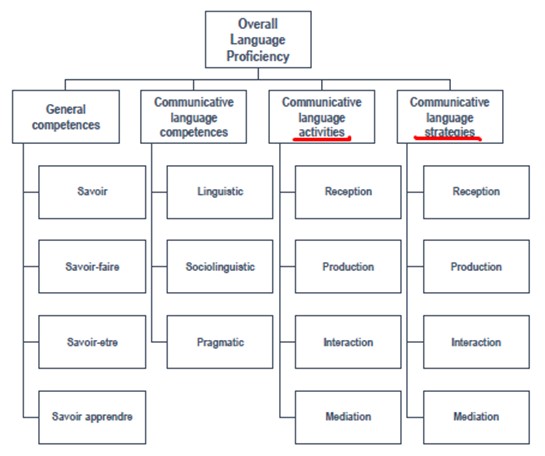language activities
ES actividades de la lengua / CAT activitats de la llengua / FR activités linguistiques / DE Sprachtätigkeit
Language activities are the different ways we use language to communicate. These can be classified according to two factors: on the one hand, how we take part in the activity (production, reception or both simultaneously), and on the other, the communication mode, which can be related to either the oral or the written communication channel.
In additional language didactics, 'use of language' activities were traditionally classified as active (speaking, writing) or passive (reading, listening) skills. This dichotomy has been questioned because of the influence of discourse analysis since reading and listening are actually not passive activities at all; instead, both entail intense and complex mental activity. A new classification prospsoed by the CEFR (2001) includes two more activities: interacting and mediating (through either interpretation or translation). The CEFR’s Companion volume (2018) adds the adjective communicative to language activities. In addition, these communicative language activities go together with communicative linguistic strategies. Therefore, in the CEFR’s Companion volume (2018: 31) communicative linguistic competence includes both language activities and strategies of use.
tasks in the language classroom should involve communicative language activities and strategies […], that also occur in the real world, like those listed in the CEFR descriptive scheme. […] The organisation proposed in the CEFR is closer to real life language use, which is grounded in interaction in which meaning is co-constructed. (CEFR Companion volume 2018: 31)
The follwing figure shows the relationship between communicative language activities and strategies (CEFR 2018: 30):

Given the importance of context, the CEFR (2001 and 2018) also classifies contexts appropriate for an activity into four fields: public, personal, educatonal, and professional. In these contexts, it stresses that 'use of language' activities are always carried out in the form of particular discourse genres with specific functions. In reference to the classroom, it is pointed out that there is a great diversity of potential activities.
Many if not most situations involve a mixture of activity types. In a school language class, for instance, a learner may be required to listen to a teacher’s exposition, to read a textbook, silently or aloud, to interact with fellow pupils in group or project work, to write exercises or an essay, and even to mediate, whether as an educational activity or in order to assist another pupil. (CEFR 2001: 57)
References
- Consejo de Europa (2001). Marco común europeo de referencia para el aprendizaje, la enseñanza y la evaluación de lenguas. Madrid: Instituto Cervantes-Ministerio de Educación, Cultura y Deporte- Editorial/Anaya. Disponible en http://cvc.cervantes.es/obref/marco/
- Consejo de Europa (2018). Common European framework of reference for languages: learning, teaching, assessment. Companion volume with new descriptors. Estrasburgo: Council of Europe Publishing. Disponible en https://rm.coe.int/common-european-framework-of-reference-forlanguages-earning-teaching/168074a4e2
